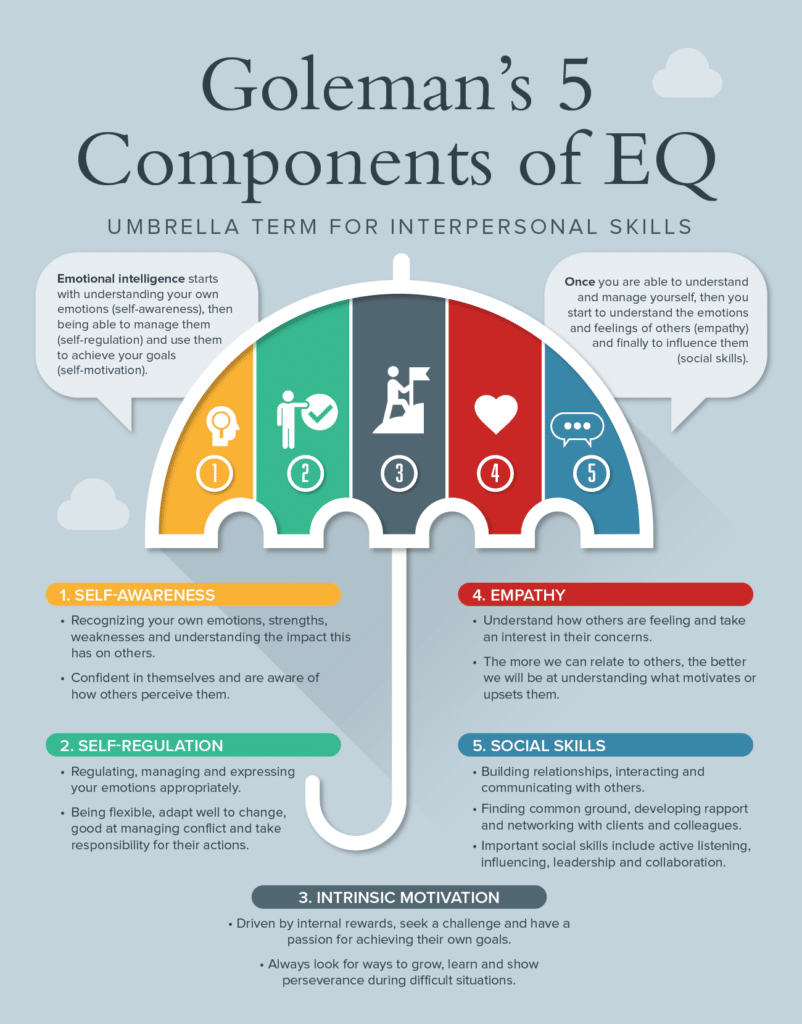Everyone talks about emotional intelligence (EI) or emotional quotient (EQ), especially among parents who want the best for their children. Unbeknownst to most people, CEOs and other top-level executives also look for candidates with high EQ.
Although it is beyond the grasp of common folks how emotional intelligence can be a huge factor in corporate success, emotional intelligence is one of the cornerstones of effective management. It would be best to understand and appreciate a comprehensive emotional intelligence definition to enable ordinary people to comprehend how this attribute can factor into one’s growth, development, success, and happiness.
Defining Emotional Intelligence
An emotional intelligence definition is more challenging to grasp than an intelligence quotient. Behaviorists define emotional intelligence as a person’s ability to recognize, comprehend, and manage emotions while recognizing, appreciating, and influencing others’ emotions. It underscores people’s awareness and appreciation of how emotions can drive behavior, how they affect others, and how to manage emotions.
Managing emotions is not as straightforward as it sounds. Some people cannot even describe how they feel, often interpreting one emotion for another. However, emotions come to the fore when people face stressful situations or under extreme pressure. A good example is meeting exceptionally tight deadlines. It is easy to become frustrated and frazzled, especially if it is already the 11th hour and you are nowhere near completing a task.

Giving feedback can also be emotionally charged for some people, especially if they do not want to hurt the feelings of others. Receiving feedback almost always has a similar effect. We are afraid of what we might hear from other people, like an insult to our personhood.
People’s emotional intelligence comes to bear in difficult and pressure-laden circumstances. Will they get angry and lose objectivity for something another person said? Will they find the situation unbearable that it would be best to give up all hope? Or, will they turn the situation into a fuel that drives them to succeed?
The Origins of Emotional Intelligence
Creating a comprehensive emotional intelligence definition is not as straightforward as appreciating intelligence quotient or IQ. After all, people have been using the term ‘IQ’ since the 1910s. On the other hand, the term ‘emotional intelligence’ or ‘emotional quotient’ has been in existence only since the 1950s. Unfortunately, it took another four decades for people to pick up on the idea that EQ could be an invaluable factor in predicting success in emotional and social situations.
Contrary to what some people believe, Abraham Maslow was the first to conceptualize emotional intelligence in the 1950s. Maslow did not call it emotional intelligence but emotional strength. In 1964, Michael Beldoch used the term emotional intelligence in his paper.
Howard Gardner was the first to underscore the inadequacy of IQ to explain a person’s cognitive ability fully. Hence, Gardner developed the Theory of Multiple Intelligences in 1983. He highlighted the role of intrapersonal and interpersonal intelligences, which would become the backbone of emotional intelligence.

In 1987, Keith Beasley published an article for the British Mensa magazine entitled, ‘The Emotional Quotient.’ Two years later, Stanley Greenspan created a model to describe emotional intelligence. The University of New Hampshire’s John D. Mayer and Yale University’s Peter Salovey refined the theoretical framework for understanding a comprehensive emotional intelligence definition a year later.
Unfortunately, it took another five years before management experts, industry leaders, and business people started appreciating the value of emotional intelligence in corporate leadership.
In 1995, Daniel Goleman published ‘Emotional Intelligence – Why it can matter more than IQ.’ Three years later, Goleman followed up his book with an article for the Harvard Business Review, catching the attention of Johnson & Johnson bigwigs. The resulting collaboration cited a strongly positive relationship between emotional competence and superior performing corporate leaders, underscoring the link between emotional intelligence and leadership performance.
Models for Understanding Emotional Intelligence
Detractors point out EQ’s inadequacy in addressing some facets of corporate leadership. Hence, theorists and researchers have been working through the years to create and refine various conceptual models and theoretical frameworks to achieve a more comprehensive emotional intelligence definition.
Of the many emotional intelligence models, two stand out.
Salovey and Mayer’s Four-Branch EI Model
Most behaviorists and social psychologists use Salovey and Mayer’s Four-Branch Model to describe emotional intelligence. The authors suggest four distinct abilities related to one’s emotions. These include perception/expression, utilization/reasoning, understanding, and management. The framework also underscores the relative complexity of each capacity as one progresses through the years.
For example, a child can perceive and express his feelings but will be unable to manage them without the parent’s help. On the other hand, an adult person can manage whatever emotions he might have by reflecting on the feelings.
The following are Salovey and Mayer’s four branches or capacities necessary for understanding emotional intelligence definition.

Perceiving Emotions
Determining a person’s emotions is easy if one can decipher the meaning in others’ body language, facial expressions, tone of voice, gestures, and other non-verbal cues.
For example, a smile might indicate happiness, sociability, amusement,
delight, or joy. However, one must also observe other signs because they might mean something else. For instance, an impish smile might indicate acknowledgment of a negative observation. A smile that reaches both ears typically means happiness.
Situational context can also play a role in perceiving emotion. Body language in a festive affair (birthdays, anniversaries, or celebrations) have a different meaning than nonverbal cues in a gloomy situation (funeral, hospital stay, and disasters).
The ability to perceive others’ emotions accurately is crucial in determining an appropriate response to any situation.
Facilitating Thought
Salovey and Mayer believed that emotionally intelligent persons use their emotional abilities to enhance cognitive processes, enabling them to adapt to different situations. It allows them to improve problem-solving, critical thinking, and decision-making skills.
Unfortunately, not everyone can harness the energy of their emotions for the positive. Research shows that critical thinking has an inverse relationship with emotions. The more emotional a person is, the lower is his critical-thinking ability.
A case in point, the 2006 Winter Olympic Games saw Tanja Frieden snatch the Olympic Championship from Lindsey Jacobellis when the latter celebrated prematurely, causing her to miss a jump and fall hard on the snow. Although Jacobellis went on to secure the silver, her momentary lapse of judgment and lack of focus cost her the gold.
On the other hand, harnessing the psychic energy coming from one’s emotions can help improve creativity and imagination. Happiness frees the mind, allowing it to think more creatively. Scientists say a positive mood broadens the visual field, enabling the person to gather more information necessary for creative, imaginative, and critical thinking.
Understanding Emotions
The third element of Salovey and Mayer’s emotional intelligence definition describes a person’s ability to analyze and comprehend complex emotions. It includes the realization and appreciation of how emotions change over time. The Four-Branch Model assumes that emotionally intelligent persons can differentiate among various emotional states, including a deep understanding of trajectories and causes.
For example, one might feel annoyed at people who cut in line. Unfortunately, annoyance is not the only emotion they might have. The person might also feel disgusted, angry, and contemptuous because the people who cut in line disobeyed the rules.
Another example is waiting in the rain, which might be annoying at first. However, if one has been standing in the rain for several hours, the annoyance turns to frustration or irritation.
Studies show that the ability to successfully discriminate between emotional states is crucial in understanding emotion. It empowers people to manage emotions more effectively and appropriately.
Managing Emotions
Emotionally intelligent persons can integrate various pieces of emotional information to devise strategies that produce positive outcomes. For example, someone cutting in line can make you feel annoyed that you want to yell at the person immediately. However, doing so can escalate the situation, causing bigger issues.
Instead, the emotionally intelligent person recognizes his frustration and allows himself to calm down first. Once calm, he can approach the person who cut in line and inform him what he did. The person might gain a different perspective from the interaction. Maybe the person who cut in line had a valid reason for his actions.
Goleman’s The Five Components Model
The Four-Branch EI Model describes emotionally intelligent people as having four unique qualities or skills. On the other hand, Daniel Goleman’s The Five Components Model proposes a five-component emotional intelligence definition. Hence, people with high EQ must score highly in each constituent.
Self-awareness
An emotionally intelligent person has a high level of self-awareness. He knows himself, including strengths and shortcomings, and is comfortable with it. The person with high EQ knows how to respond to certain people and situations, empowering him to motivate others, meet goals, and create an inclusive and fair atmosphere for everyone.
For example, a person with a low EQ might make bad decisions when in a bad mood. Conversely, an emotionally intelligent person recognizes the negativity, isolates it, and refocuses his energy on the task.

Self-regulation
Just as sound is slower than light, so does rational thinking relative to emotions. The brain processes emotions at lightning speeds compared to logic, where the mind integrates various information to produce a logical and rational action.
Self-regulation describes a person’s ability to recognize, monitor, and manage his emotions, energy states, behaviors, and thoughts in acceptable ways to produce positive outcomes, such as learning, loving relationships, and overall well-being.
A person with high EQ is calm amidst adversity, is approachable, and leads by example. He creates a nurturing and motivating environment while dealing with conflict constructively.
Motivation
Most people think of motivation as one’s inherent drive for promotion, money, or other measures of success. However, Goleman’s definition refers to motivation as one’s desire for enjoyment, including passion and optimism.
Emotionally intelligent people always look at the silver lining on a bad day. They never run out of energy to fix problems. People with high EQ will also cheer others to persevere.
Empathy
One characteristic of emotionally intelligent people is empathy – the ability to emotionally understand and appreciate other people’s feelings and perceptions by putting oneself in others’ shoes. It is different from sympathy, where the understanding comes from one’s perspective.
For example, it is easy to sympathize with someone who lost a loved one. However, empathizing with this person is different because one might not understand how the dearly departed means so much to the bereaved. Putting oneself in the person’s shoes is not a straightforward process because one must appreciate the person’s actual feelings and thoughts about the situation from the person’s point of view.
Social Skills
The last component of Goleman’s emotional intelligence definition is social skills. It comprises a person’s competencies for facilitating communication and interaction with others. It also requires knowledge about different communication modes, including verbal and nonverbal.
Social skills are a must in everyday life unless one is a hermit. Emotions are often the result of human interactions. For example, a person cutting in line can elicit a hostile reaction from others in the queue. Learning how to successfully navigate the complex web of interpersonal relationships is crucial to achieving high EQ.

Emotional Intelligence in Everyday Life
Emotional intelligence is crucial in everyday life, including the workplace. Employees with high EQ have excellent interpersonal relationships, allowing them to thrive in a collaborative work environment. They minimize, if not eliminate, discord by understanding and appreciating the emotions of others, and shaping their responses to promote a positive outcome.
Emotionally intelligent employees make exceptional customer service front liners. They can empathize with clients to better understand their concerns, allowing them to forward a win-win solution for any conflict. They can also establish and nurture positive relationships with customers and potential clients, providing more meaningful interactions that can contribute to the company’s goal of expanding its customer base.
Employees with high EQ can decipher nonverbal cues from superiors, peers, and customers. They have an emotional radar that triggers their brain to devise strategies to defuse a volatile situation. For example, a co-worker with a frowning face and arms across the body might suggest disgust or annoyance. The person with a high EQ can approach the co-worker to determine the cause of the observed behavior.
Workers with exceptionally high EQ also improve their chances of landing a leadership role. Evidence shows that emotional intelligence is a necessary competency of effective leaders and is the most powerful predictor of personal success and professional excellence. As Daniel Goleman revealed in his book, emotional intelligence allows leaders to combine thoughts and feelings.
Emotional intelligence also empowers employees to improve team efficiency. Managers with high EQ can motivate others effortlessly by nurturing their human side. They make decisions that hinge on employee happiness and good mood, allowing workers to improve efficiency and productivity.
Measuring Emotional Intelligence
Assessing a job candidate’s emotional intelligence is less straightforward than measuring an applicant’s IQ because of the subjective nature of emotion. However, there are several assessment tools HR professionals can use to gain a clearer picture of a person’s emotional intelligence. Although these tests do not accurately reflect a job candidate’s emotional quotient, they provide a rough estimation of his emotional maturity.
- Mayer-Salovey-Caruso Emotional Intelligence Test (MSCEIT)
This assessment tool is specific to the Four-Branch Model emotional intelligence definition. The MSCEIT underscores emotional attunement to social norms. Although the test is almost similar to an IQ test in construction, the 141 items lack objectively correct answers or responses.
- Emotional Competence Inventory (ECI)
The Hay Group developed the ECI in 1999 to help researchers measure the emotional intelligence of respondents using David Goleman’s Five Components Model. It assesses 18 competencies across four areas: self-awareness, relationship management, social awareness, and self-management.
- Situational Test of Emotional Understanding (STEU)
This assessment tool measures a person’s emotional understanding. Each point in the 42-item STEU questionnaire comes with five emotional responses. The test-taker must choose which emotion will most likely result from a hypothetical emotional situation.
For example, the test might ask what a person who completed a challenging task on time even with a limited budget might feel. The responses are pride, surprise, relief, joy, and hope. The test-taker’s answer reflects how he processes the given emotional situation.
- Situational Test of Emotional Management (STEM)
This emotional intelligence test is similar to the STEU, except it contains only 44 STEM items with four behavioral responses each. The assessment tool estimates the person’s emotional maturity by measuring answers to emotional situations.
Human resource professionals must know there are other assessment tools for emotional intelligence. These include the BarOn EQ-I and the Trait Emotional Intelligence Questionnaire. Interestingly, TEIQ scores correlate positively with four of the Big Five Personality Test’s domains, namely, conscientiousness, openness, extraversion, and agreeableness.
Final Thoughts
Emotional intelligence is a crucial attribute of leaders and people with exceptional interpersonal relationship skills. They promote cordial interactions, mitigate conflicts, and facilitate collaboration and teamwork amidst a diverse and stressful work environment. Unsurprisingly, HR professionals must evaluate a job candidate’s emotional intelligence if they want an employee who will fit the job perfectly. However, employers must also combine EQ assessment results with other pre-employment tests, such as cognitive aptitude, personality, professional competencies, and attitude. It is the only way organizations can ensure they hire the best-fitting candidate for the job.
